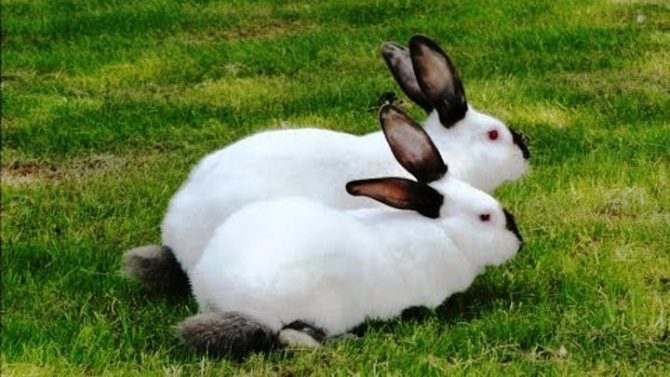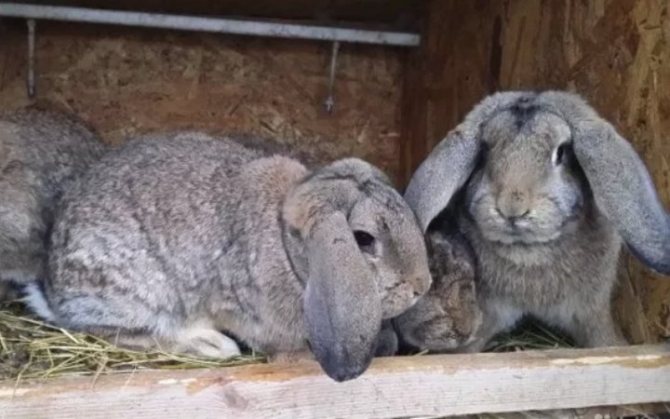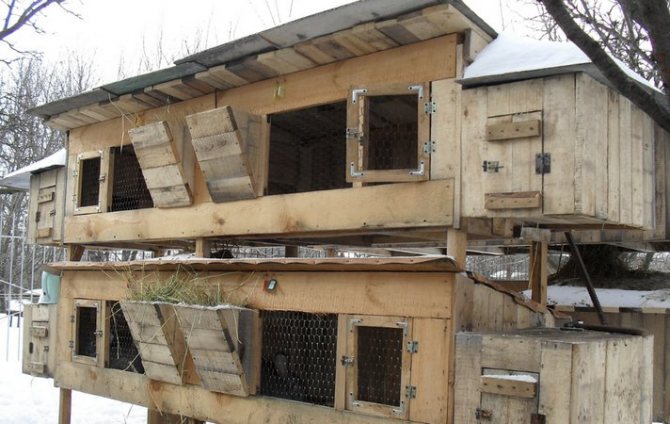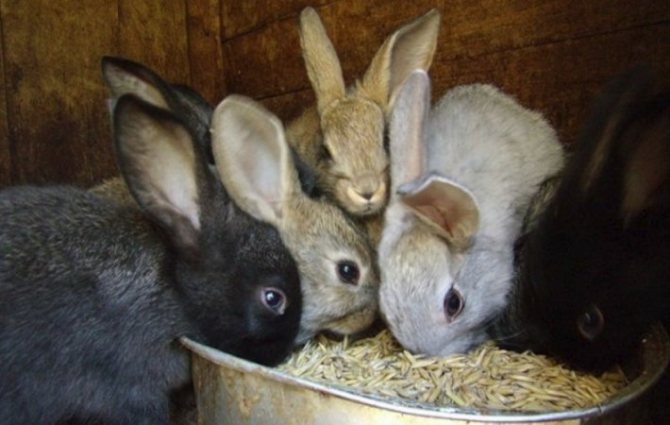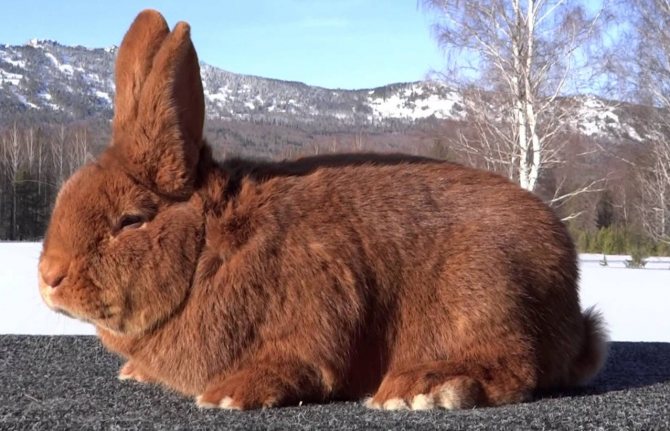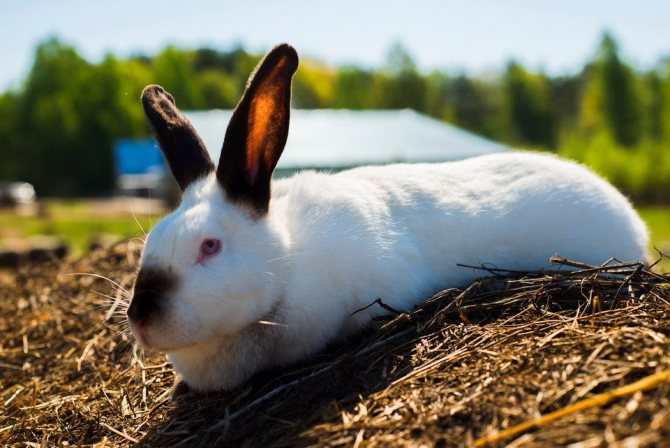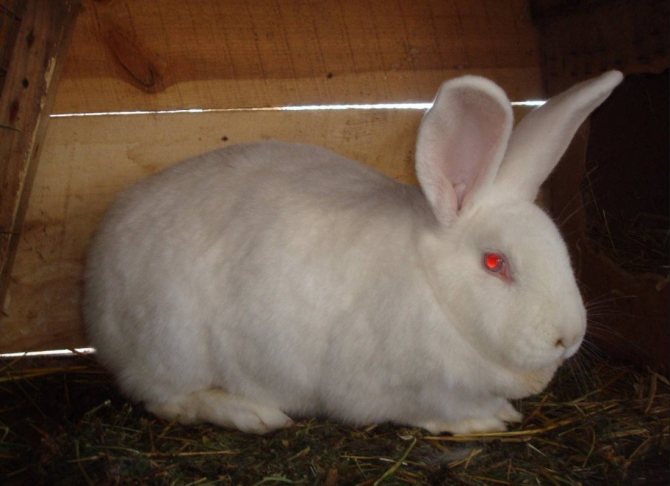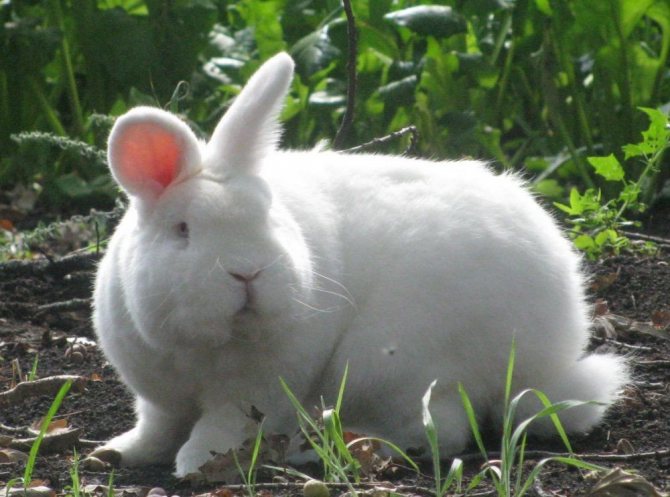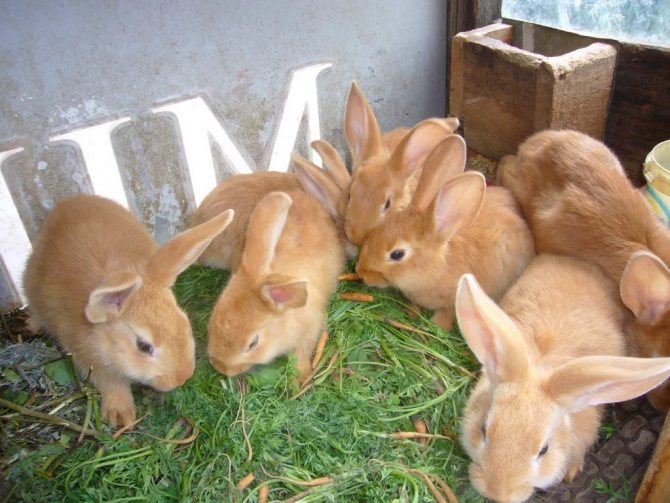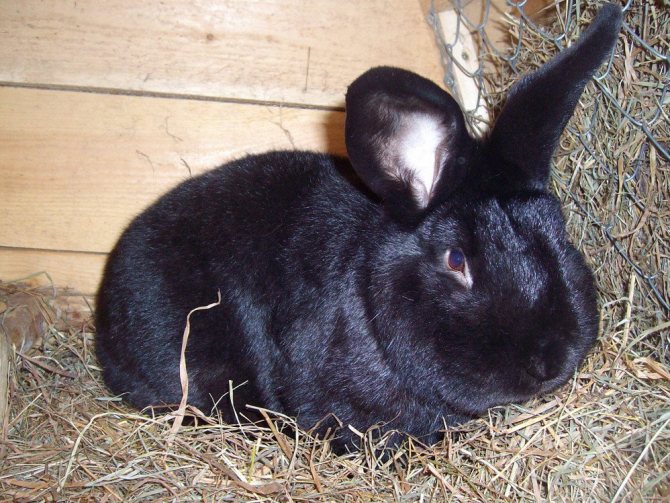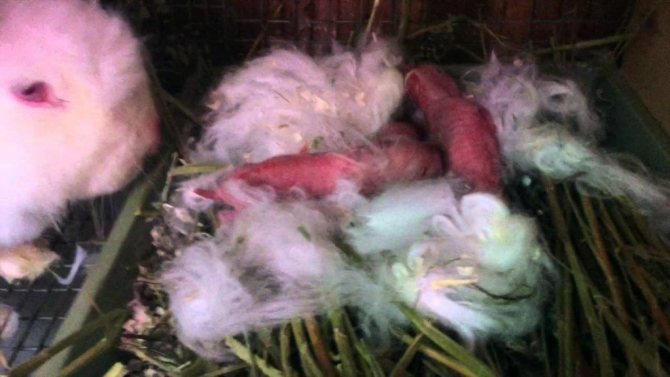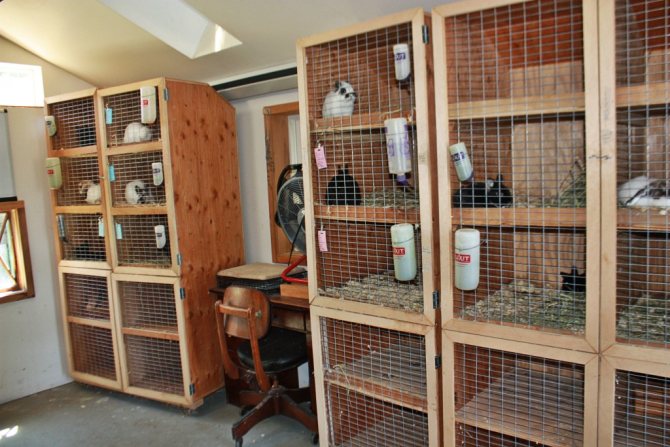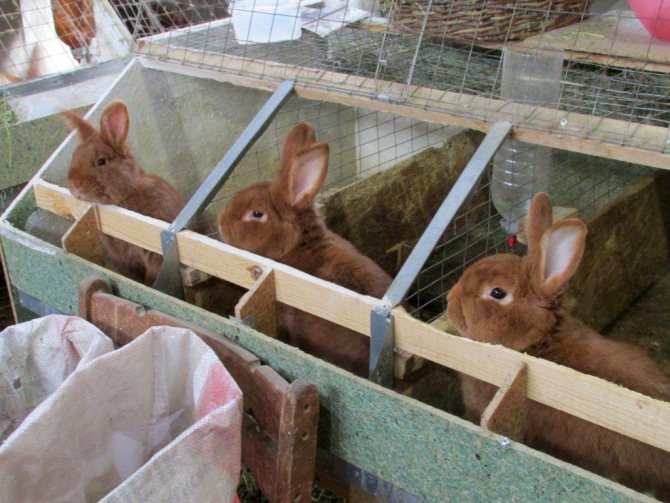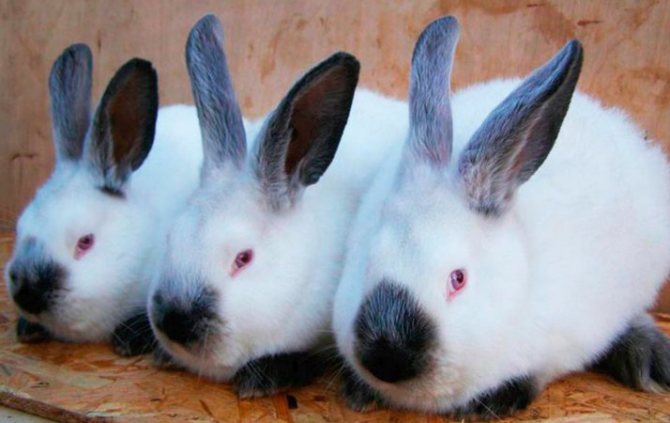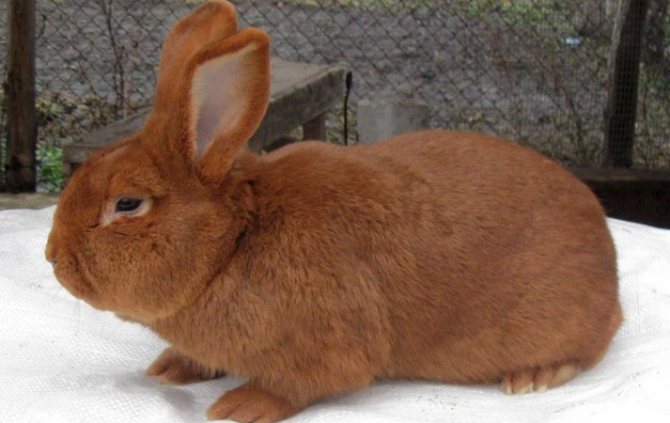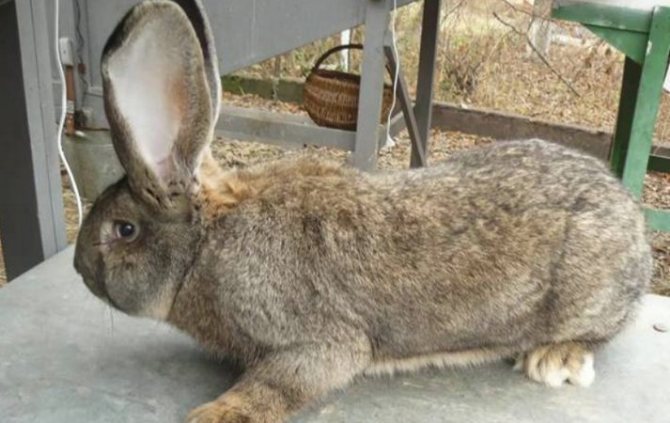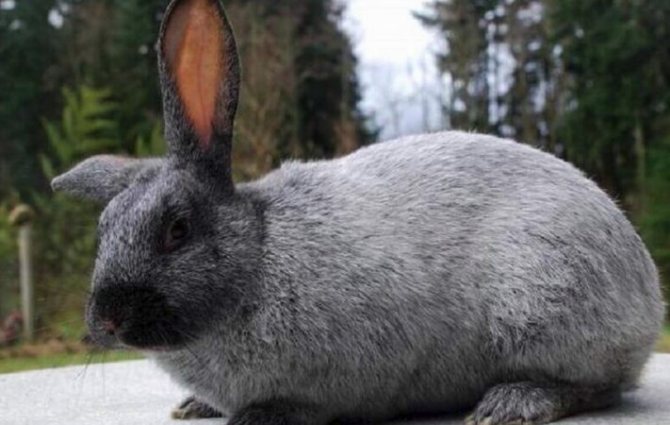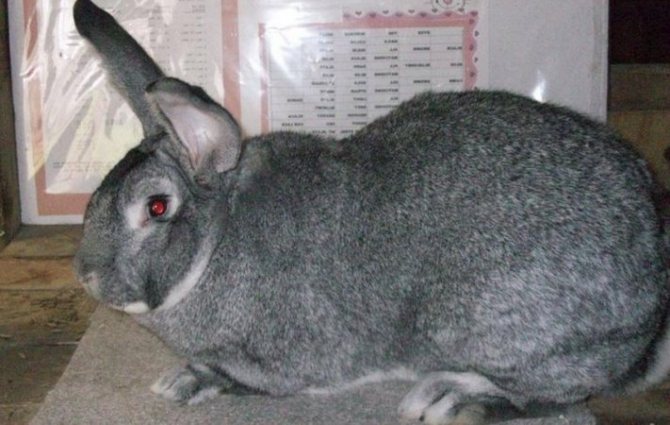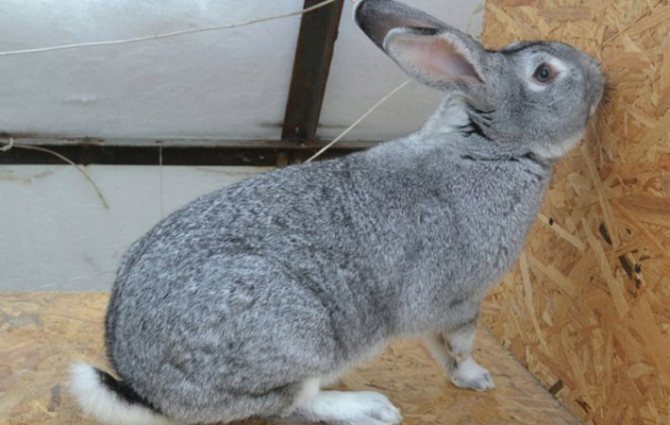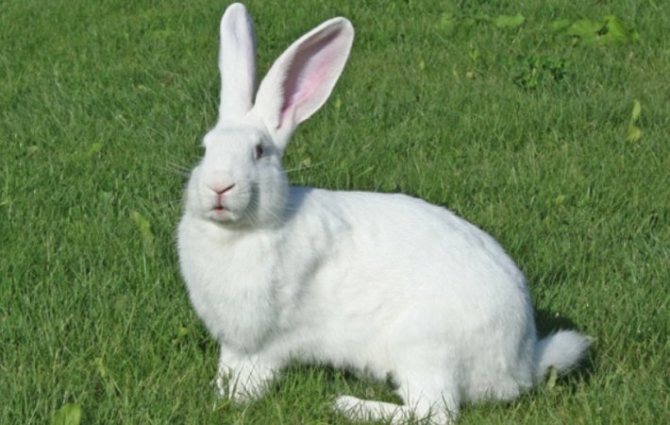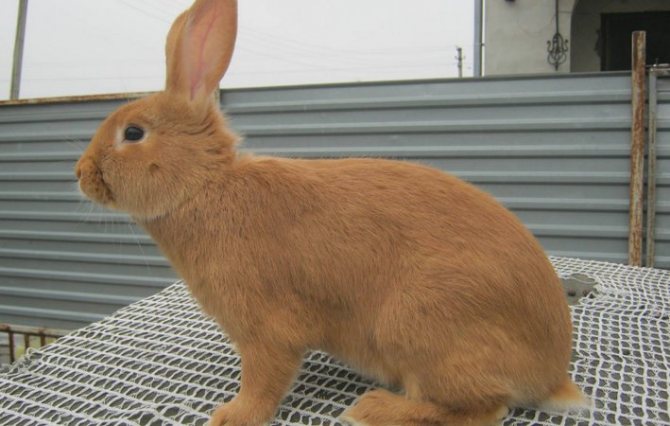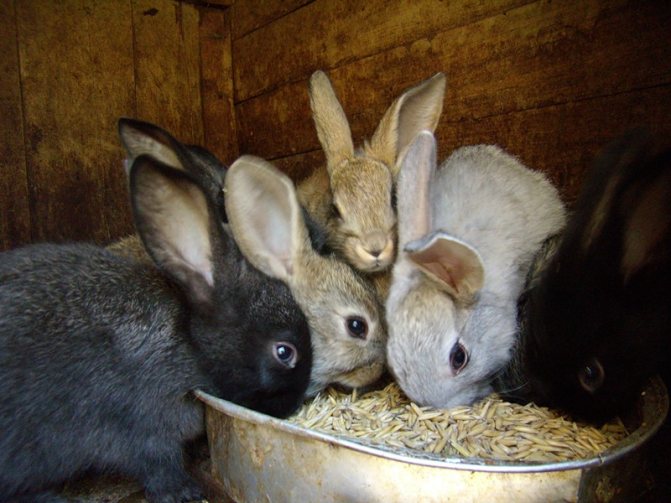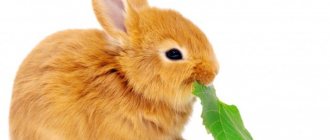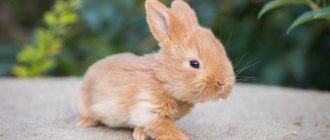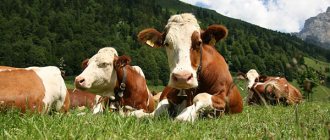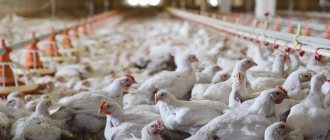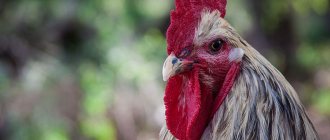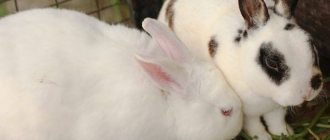How fast rabbits grow, rabbit growth chart
Rabbits are born blind, naked and helpless, weighing 40-80 g, by the end of the 4th week their live weight increases 10 times. By the end of the first day, the rudiments of the primary hairline are formed on the head, on the 5-7th day, the hairline appears on the entire body, by the 20-25th day, its development is completed, and then gradually begins to be replaced by the secondary hairline. By the time of puberty, this process is complete. On the 10-14th day, the rabbits begin to see, and on the 15-20th day they can already leave the nest and eat food on their own (the exit of the rabbits from the nest at an earlier age indicates a low milkiness of the rabbit).
The Californian and New Zealand white rabbits are especially vigorous.
In terms of growth intensity, meat-skin rabbits are inferior to meat-skin rabbits.
Rabbits raised with full feeding weigh 2.5-3.5 kg, which is 50 times higher than the live weight of a newborn.
The milk production of rabbits is one of the main factors of the high growth rate of young animals, not only during the suckling period, but also in further periods of its development. The growth rate depends on the biological value of milk and the milk production of rabbits. The milk yield of rabbits is influenced by the conditions of keeping, their age, season of the year, the number of offspring, the lactation period, the number of rabbits in the nest, and the breed. The milk yield of rabbits in summer is slightly higher than in spring. In young rabbits, milk production is low, because the body is still at the growth stage. During the period of physiological maturity of animals in the second and third lactation, milk production is highest, which is associated with an increase in the functional activity of the mammary gland. In rabbits of the Soviet chinchilla breed, milkiness is slightly higher than in white giant rabbits, which indicates the influence of the breed on milkiness. Among the rabbits of meat breeds, the highest milkiness in the Californian rabbits and less in the females of the New Zealand White breed. Dairy and low-dairy rabbits have exterior differences, which makes it possible to visually select rabbits by their milkiness. In dairy rabbits, the chest girth is 7%, and the body length is 2% more than the same indicators in dairy rabbits, and the live weight is less on average by 700-800 g. Dairy rabbits have a somewhat elongated (stretched) body, a well-developed and strong skeleton, deep chest, firm, elastic, thin skin. Low-milk animals are characterized by a large live weight, a compact, shortened body. They have shallow breasts and more developed subcutaneous tissue.
For good growth of rabbits during the sucking period, it is enough if the rabbits produce 100-200 g of milk per day. The duration of lactation depends on the intensity of the use of rabbits (lactation usually lasts 40-45 days), and with compacted litters - 27-28 days. Milk production stops 2-4 days before birth and resumes after a new birth. During the lactation period, the rabbit secretes from 3.5 to 5 kg of milk, this is considered good milkiness.
The mammary glands of the rabbit are located along the body. On either side of the midline of the abdomen, there are 8 to 10 nipples.
In the first 2-3 days of lactation, the mammary glands of the rabbit produce colostrum - a product resembling cream in consistency, which has not only high nutritional value, but also protective functions. Colostrum contains enzymes, a large amount of nutrients, immune bodies, it has a protective effect against various diseases, has a beneficial effect on the gastrointestinal tract of newborn rabbits.
Milk contains a large amount of dry matter, up to 30-36%, including 10-15% protein, 10-20% fat, 1.8-2.1% milk sugar, 0.64% calcium, 0.44% phosphorus , vitamins, which contributes to the extremely intensive growth of rabbits during the suckling period.
The chemical composition of rabbit milk varies with the season of the year. In summer it contains about 14% protein and 13% fat, and in winter, respectively, 12 and 17%.
You can judge the milkiness of rabbits by the state of the rabbits in the nest. In dairy rabbits, the rabbits lie quietly in the nest, grow well, the shape of their body is round, the hairline is shiny, the skin is dense, without wrinkled folds, if the rabbits begin to creep or leave the nest before 15 days of age, this is the first sign of low milkiness of rabbits. At the same time, in rabbits, the coat is disheveled, the skin is dull, wrinkled, and their stomach is usually empty. Quite often, the rabbits squeak, suck each other, weaken, lag behind in development and often die. From such low-dairy rabbits, some of the rabbits should be transferred to abundant dairy. To check if the rabbit has milk, it is enough to lightly press on the nipples with clean hands. In multi-milk rabbits, milk is secreted in trickles. Obesity can be the reason for low milkiness.
It is possible to more accurately determine the milk production of rabbits by the increase in live weight of rabbits in the first three weeks of life. During this period, they feed only on mother's milk. The secretion of milk increases up to the 20th day with normal roundings and up to the 17-19th day with compacted ones. For an increase in 1 g of live weight of rabbits, an average of 2 g of milk is consumed. To determine the milkiness of a rabbit, you can use the formula
where M20 is milk production for 20 days,
W1 - live weight of rabbits at birth,
W2 - at 20 days of age,
2 - coefficient of conversion of the increase in live weight of rabbits into milk production of rabbits.
Maintenance and care
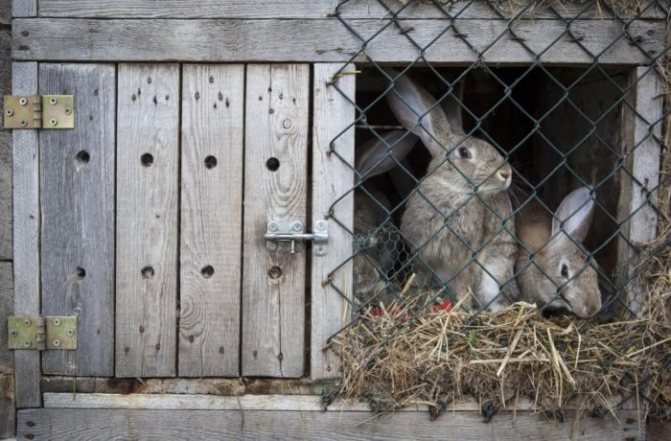
Caring for eared beef breeds is not too different from the requirements for breeding regular rabbits. Therefore, we have selected some rules for you that will significantly simplify the choice of conditions for meat breeds and tell you about what parameters and conditions young and adult rabbits are sensitive to.
If you decide to professionally engage in rabbit breeding, we advise you to pre-purchase all the necessary equipment, a supply of food and bedding for the first time. Therefore, we will consider each of the criteria separately.
Indoor standards: cage, humidity and temperature
The rabbit's place of residence is a cage, the average volume of which is 50 * 80 * 70 centimeters. You can design it yourself if you want to save money on the arrangement of a subsidiary farm or a personal farm.
To make a cage with your own hands, stock up on sheets of plywood, a metal or polymer net, as well as beams and miniature boards. A frame is created from the bars, which is covered with a mesh or sheathed with boards.
The doors are made of mesh and should face south. It is important to cover the bottom of a homemade cage correctly: wood shavings and hay will do. If there are a lot of rabbits, make cages in several tiers.
The mother tongue is a wooden box that imitates a burrow. The fact is that it is in the hole that the rabbit reproduces her offspring. It is needed in a room where there are cages or a whole enclosure with rabbits.
Making a mother cell with your own hands is quite simple. For construction, put together a wooden box with a format of 50 * 30 * 35, drill a hole 25 centimeters in diameter on either side, and a mobile inclined cover is fixed on top.
The design itself is somewhat reminiscent of a birdhouse. At the bottom, you need to lay a thick layer of litter, because it is in the mother liquor that the first month of life of newborn rabbits will take place.
But what can you say about the room in which you need to arrange the cells? The temperature in it should range from 10 to 20 degrees Celsius, and the humidity should not exceed 75%.
Even a barn will do, but in this case, install a heater in it, insulate the walls and repair it so that the weather does not damage the animals.
It is better to cover the roof with roofing material or slate. Experienced rabbit breeders also advise to fence the area opposite the exit from the rabbitry or on the side with a net covering.
But in this case, you will need to make small passages for the animals. In it, pets will be able to walk, stretch their legs and breathe fresh air. It is best to direct the walking area to the southeast, so that there is as much natural light as possible from the oblique rays of the sun.
Cleaning
In order to protect rabbits from diseases and increase their viability, all sanitary standards must be observed. The regular cleaning that everyone talks about includes daily scrubbing and fluffing of the cage bedding, replacing the cover as it gets dirty.
Disinfection of rooms with rabbit cages, even in a personal economy, even on a farm, should be carried out at least twice every 30 days, as well as when the animal moves from one room to another.
This process includes scalding the cell with boiling water, as well as processing with a 1% formalin solution. It is also necessary to create high-quality ventilation in the room or ventilate it often.
Otherwise, you run the risk of encountering an unpleasant characteristic odor. During cleaning, you need to provide the rabbits with the opportunity to walk outside the premises for permanent residence. This is why you need a well-equipped aviary with the possibility of year-round walking.
Feeding rabbits for meat
The rabbit eats a lot by default, but feeding rates vary by weight. Dried grass is the main component of nutrition for an individual of any age; store at least 500 kilograms of feed per individual per year.
In summer, the diet should include more juicy elements: pumpkin, boiled potatoes, zucchini, legumes and squash. In winter, provide your pets with straw, hay, as well as leftovers from the human table without bones, meat, mold and signs of decay.
Do not forget about natural vitamins: pine needles, chalk and salt. But how do you provide food for the fattening rabbits? We will talk about this in the next paragraph.
How fast do rabbits grow?
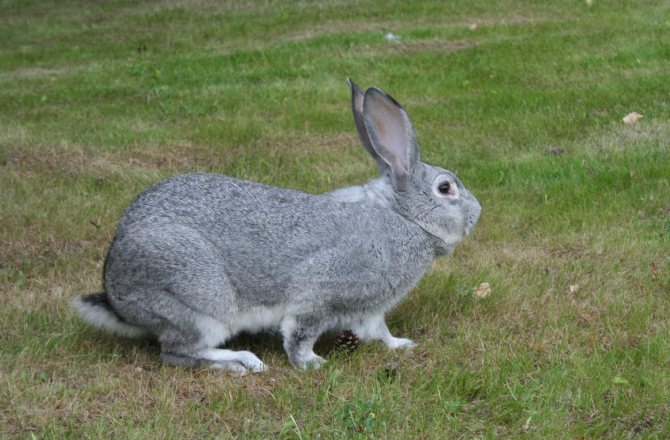

The early maturity of rabbits is far superior to all types of animals raised in agriculture. Intensive growth is characteristic of the embryonic period and the next 120 days after birth. Animals reach sexual maturity by 4 - 5 months, and as a rule, at this time, their average weight is 3.5 kg.
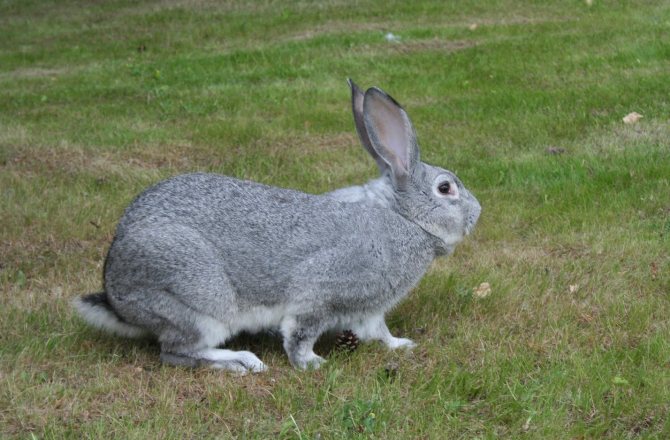

The young are born absolutely helpless, bare with hair and completely blind. The average weight of one rabbit, depending on the breed, can be 40 - 80 grams. By day 28, a tenfold increase in live weight is noticeable. If young animals begin to leave the nest from the 15th day and feed on adult animals, attention should be paid to the milkiness of the female.
The youngest New Zealand white and Californian rabbits have the highest growth vigor. Intensive growth in the meat direction, in this the representatives are one step higher in comparison with meat-skin animals.
The growth rate of young animals largely depends on the female's milk performance, but not only during sucking, but also in the future.The biological value of dairy products fully affects the intensity of growth. To ensure good performance, the following factors must be considered:
- how females are kept;
- age category;
- season;
- number of okrols;
- belonging to a particular breed group;
- the number of young animals in the female;
- lactation period.
In summer, female productivity is higher than in winter. Young rabbits differ in relatively low rates, which is associated with a growing body. When physiological maturity sets in, the highest milk production rates are recorded. Soviet chinchillas are considered to have a higher milk yield than white giants. In the meat direction, the Californian breed is in the lead, and the New Zealand White is in the last place. This is how the belonging to a particular breed group affects such an important indicator.
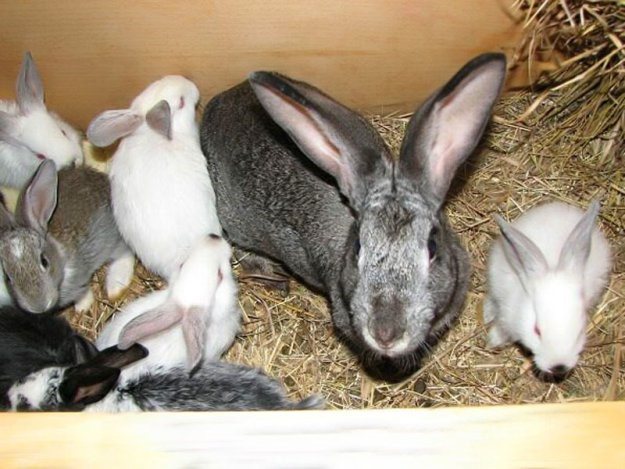

growth of rabbits will be provided with an average milk production of 100 - 200 grams per day. The length of the lactation period depends on how intensively the female is used. The usual duration is up to 45 days, and if compacted okrols are used up to 27 - 28 days. Milk stops flowing a few days before delivery, and reappears after okrol occurs. Good milkiness in that rabbit that during the lactation period was allocated 3.5 - 5 kg of milk.
Choosing a breed for breeding
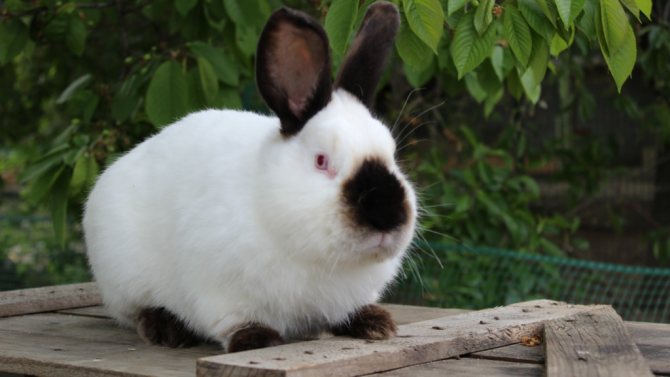

California rabbit
Farmers raise rabbits for specific purposes, because animals are needed not only for the soul, but also for financial profit. Yes, you can't get their dietary meat just like that.
Rabbit breeding requires a lot of money and effort, but thanks to breeders, many breeds have been developed that are easy to gain muscle mass.
Which rabbits to choose for breeding for meat? This question has plagued farmers for many years. We have compiled for you a selection of the most common and profitable breeds of eared breeds for breeding for meat.
California rabbit
It has distinctive external features: a white body and black markings on the limbs. According to the constitution, the Californian breed does not differ from other meat breeds.
Such rabbits are famous for their high fertility, for one okrol even a young rabbit brings up to 12 babies. Both rabbits and adults do not differ in capriciousness in food, but they have good natural immunity.
Rabbit meat has a low percentage of fat, since Californians poorly absorb lipids. Adults on the market do not have a huge price tag. Therefore, it is often the Californian rabbit that is chosen as a farm animal that is raised for meat;
Representatives of the white New Zealand rabbit breed
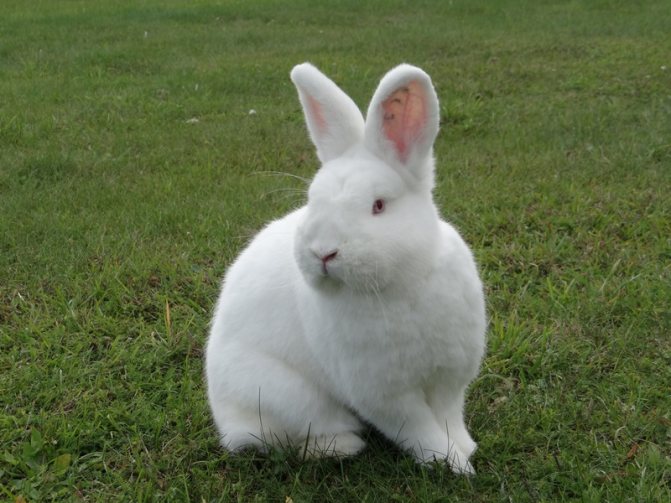

They have a powerful muscular body, short legs and characteristic scarlet pupils. The mass of an individual older than six months reaches 5000 grams, and the growth of the white New Zealand varies between 45 and 60 centimeters.
With such impressive dimensions, rabbits have a minimal layer of adipose tissue. Farmers also distinguish that such rabbits ripen quickly and bear fruit abundantly, are unpretentious in care, have a calm temperament, and are also resistant to most viruses and diseases of large rodents.
Of course, such wonderful qualities will come with a price: the price of New Zealand white is the highest on the market;
White giant
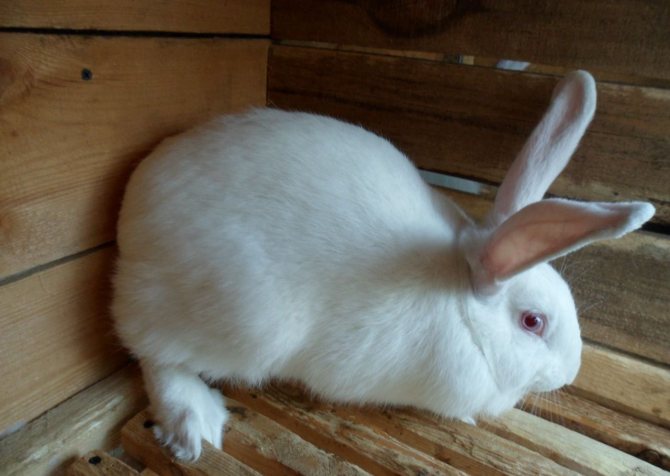

A bit like the first breed: red eyes, thick white hair and delicate undercoat ... The live weight of such a rabbit varies between 4 kilograms and 8 kilograms, and the proportion of pure meat suitable for consumption is no less than 75%.
The peculiarity of this breed lies in the increased milkiness, the average female gives from 200 grams per day. That is why the rabbit easily feeds someone else's offspring, and by 60 days of life, the rabbits reach 2 kilograms in weight.
With quality nutrition, the rabbit can feed babies for more than 2 months.But there is also an unpleasant feature, these rabbits are prone to disease. That is why white giants need an insulated aviary;
A related breed is called the Gray Giant
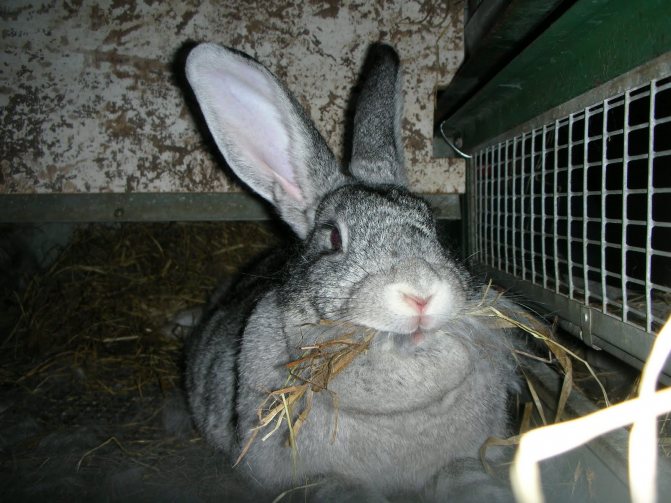

These rabbits are distinguished by an impressive constitution, a small rounded dewlap, and the body length of the gray giant exceeds 40 centimeters.
A positive feature of the rabbit is its early maturity, in which it can compete with the white New Zealand breed. Gray giants are famous for their good immunity, and also quickly gain body weight.
By 3 months with normal nutrition and pre-feeding with high-calorie milk, female rabbits weigh more than 2000 grams.
Growing gray giants does not require much effort and investment, which makes the breed one of the most popular among professional farmers and amateurs;
Flanders
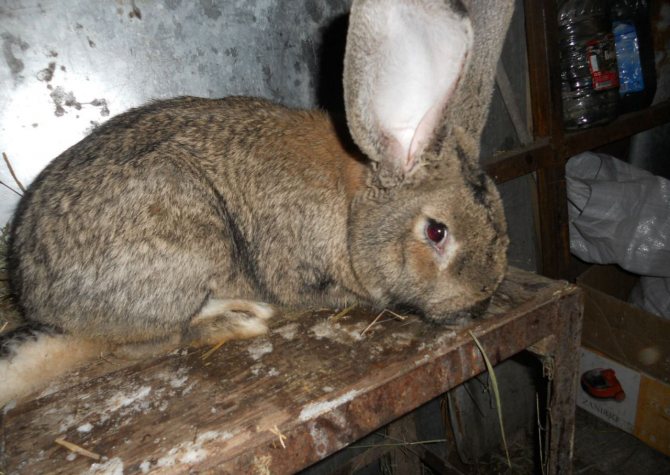

Known as the Belgian giant. It is not difficult to understand that this rabbit holds the record for weight: official sources have information about fattening flanders up to 25 kilograms, although the standard weight of the Belgian giant does not exceed 11 kilograms.
Another feature of this breed is its huge ears, if their length does not reach 20 centimeters, the flanders are not allowed by breeders to reproduce.
Rabbits have a heightened maternal instinct and produce up to a dozen babies at a time. But such rabbits do not differ in early maturity: they reach sexual maturity no earlier than 6 months.
Other disadvantages of flanders include low meat yield, tendency to obesity, high appetites, exactingness to living conditions and menu.
What determines the growth rate?
The rate at which rabbits grow depends largely on their breed.
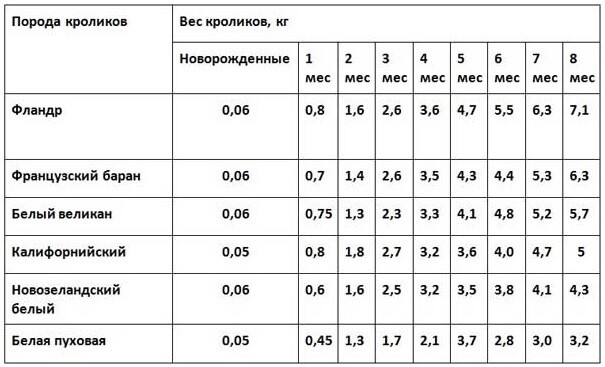

In addition, the growth rate is influenced by nutrition, which at first consists of breast milk, which contains all the nutrients and vitamins. Thanks to this, immunity is developed, which protects the animals for their entire life allotted to slaughter.
The lactation of the female depends on the following factors:
- conditions of her detention;
- the breed to which she belongs;
- age;
- the number of births before;
- the time of year when the okrol occurred;
- the number of newborns;
- the time during which feeding takes place.
There are many high-milk breeds. Among the rabbits raised for meat, the Californian breed takes precedence, and the New Zealand White takes the last place. The most favorable for high lactation is the summer period, when the female is provided with adequate nutrition.
How to feed rabbits raised for meat?
One of the important factors that makes it possible to quickly feed rabbits for meat is their good keeping conditions. To obtain a large volume of dietary meat, rodents must begin to feed when they reach two to three months of age. Prior to this, they are also introduced into the diet as a supplement to breast milk and do so gradually.
To improve the taste of meat, they begin to pay increased attention to the diet - a month before the expected slaughter date. This period depends largely on the age of the animals and their physical condition.
There are three stages of animal feeding:
- preparatory;
- main;
- final.
The preparatory stage is understood as the time during which a suitable diet is selected. During the main, there is a rapid weight gain of animals. The final one is devoted to adjusting the weight gained by the animals and the component of the fat reserve.
At the preparatory stage, animals should receive high-calorie food. In addition to greens, roughage and succulent feed, double the amount of more concentrated feed is introduced. If fattening takes place in the winter, then the percentage of hay and branches is reduced. However, eared rodents should receive vitamins and minerals in the required amount.Otherwise, weak immunity can lead to disease. The preparatory stage does not last long - several days. The best products for him are compound feed, legumes, corn, wheat, barley, oats.
At the main stage, the goal is set - the formation of a fat layer. This requires products that have a high concentration of fats: sunflower seeds, cake, boiled potatoes. The amount of hay and root crops is limited. Cereals cooked in milk contribute to the accumulation of fat. Rabbits should be constantly monitored for their delicate stomachs. Do not exceed the daily fat allowance. The main period lasts about a week.
At the final stage, special attention is paid to the appetite of pets. It is necessary to ensure that the rabbit eats all the food offered to him during the day. To increase his appetite, various spicy stimulants such as celery, cumin, dill and others are added to his food. You can add some salt to your drinking water. Hay and green fodder are no longer offered, but the combined one is given as much as possible. It should be borne in mind that the increased nutrition of the animal with grass will make its meat more rigid.
Ways to increase the weight of rabbits, which are additional
There are methods that are also used to increase the mass of fattening rodents:
- Correct grouping. Each offspring contains strong and weaker rabbits. So that they all get food equally, and no one goes hungry, it is necessary, guided by this principle, to plant them in different cages,
- Area limitation. Rabbits are active animals and lose some of their weight with frequent movement and running around the cage. To avoid this, part of the territory of the cell is limited.
- Increasing the frequency of food intake. It is brought up to 4-5 times a day as the trough is emptied.
Since rabbits are considered nocturnal animals, you can darken the cage and offer food at this time to increase appetite. It is not worth doing this constantly, since this can affect the health of the animals.
Vitamin Supplements for Weight Gain
Vitamins should be dissolved in drinking water or mixed in wet bran. Vitamin D supplements cereals. Vitamin C acidifies water. Feeding animals can also be given vitamin and mineral supplements called premixes. Rodent health will be strengthened by microelements: phosphorus, manganese, calcium.
At what age are rabbits slaughtered?
The choice of rabbits for slaughter depends not only on their age, but on their achievement of optimal weight, the acquisition of the condition of the fur cover. Slaughter ahead of time or, conversely, later will lead to a deterioration in the quality of meat and fluff. Increases the profitability of selective slaughter.


There is a dependence of the time of slaughter of downy rocks on the molting period. Animals that were born at the beginning of the year are slaughtered when they are about 4 months old between the first and second molt. If you want to get full-fledged meat, you should take into account the timing of the vaccination. You can score if at least 30 days have passed since the last vaccination.
How do you select rabbits for slaughter?
You can slaughter rabbits that have reached four months of age. There are differences depending on the purpose of the breeding of the animals. For beef breeds, an important criterion is a set of sufficient mass. If the content and choice of the diet were carried out correctly, then the weight at this age should be about 3-4 kg, depending on the breed of animals.
It is recommended to carry out selective slaughter - to leave the healthiest and heaviest animals for further breeding. This is an economically sound approach.
To obtain full-fledged skins suitable for further dressing, the best option is to slaughter rabbits born in the winter. This will make it possible to obtain high-quality and beautiful fur.The skin of rabbits, which were born in the summer, has a lower price. The cost of this type of raw material will not be too high if the slaughter of young animals is carried out.
Slaughter preparation
It is advisable to inspect rabbits by a veterinarian in order to reject sick animals. Isolation should be made - individuals selected for execution should be placed in a separate small cage for a day.
In order for the animal to clear the intestines, you should stop giving it food at least 10-12 hours from the expected time of slaughter. You can extend this period by a day. Water continues to be given not to quench thirst, but to remove feces from the body.
Before slaughtering, it is necessary to wash the rabbit and let it dry. Rabbits are shy animals, so you need to choose a quiet, calm place for slaughter. There should be no strangers or other pets.
Prepare all the necessary tools in advance and protect the surface from traces of blood with a film. The employee must wear an apron and gloves.
How long do rabbits grow from birth to slaughter
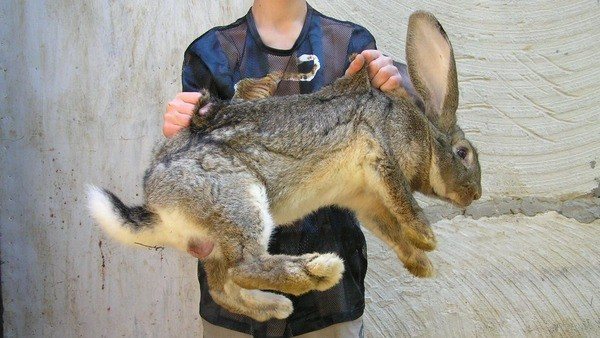

Rabbits grow very quickly, according to this parameter, they bypass all other animals. The most intense growth occurs in the first 120 days. At 5 months, animals are already able to reproduce on their own. By this time, they reach 3 and even 5 kg. Many are interested in how long rabbits grow, it is in the first 150 days that the most intensive growth occurs.
Bunnies are born completely blind and bald. Average weight is 40–80 grams. For a month, the mass grows 10 times. From now on they can try to eat food, but still need milk. If the young leave the rabbit earlier, something is wrong with her milkiness.
The California and New Zealand white rabbits develop the fastest. Moreover, the meat directions in this parameter significantly bypass the meat-skin ones.
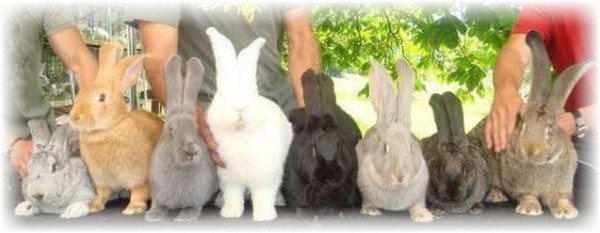

The growth rate directly depends on the quantity and quality of the rabbit's milk. Together with it, the body receives not only vitamins and nutrients, but also maternal immunity. Lactation depends on many factors, including:
- Conditions of keeping the female;
- age;
- season;
- number of okrols;
- breed;
- brood size;
- lactation period.
The highest milk breed is considered to be the Soviet chinchilla. At the same time, the peak of productivity falls on the summer. During this period, the diet is as complete as possible with everything necessary for the animal itself and lactation. Among meat rabbits, the first place is occupied by the Californian breed. The female produces 100-200 grams of milk per day. For the entire feeding period, one rabbit produces 3-5 kg of milk.
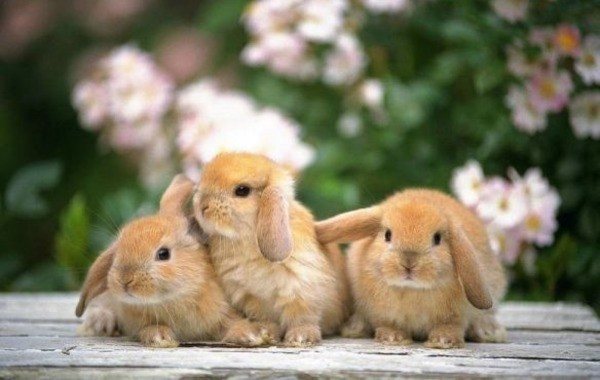

To determine how quickly and to what age rabbits grow, they can be divided into three periods:
In the first period, the growth rate is high; from birth, the mass can grow 7–10 times. The second period is characterized by the fastest growth and weight gain. In the last period, weight gain slows down. Further, it is reduced to a minimum. Different rabbit breeders, rabbits grow before slaughter at different times. While some consider the optimal age for slaughter to be 3 months, others keep it up to 5. At the age of 90 days, growth slows down significantly, from a business point of view, it is more profitable to grow a new generation. For small breeds, growth can last up to 6 months.
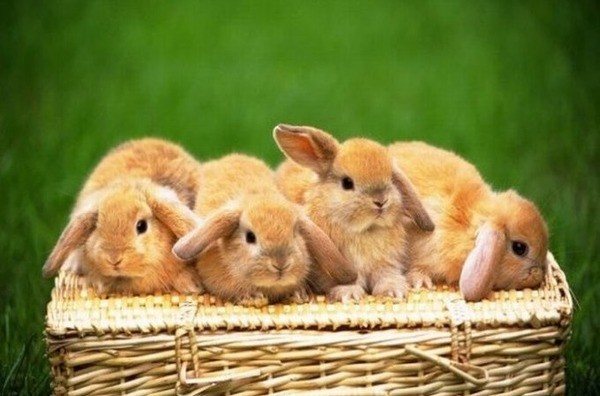

During the slaughter period, the rabbit should have the maximum amount of muscle tissue. The indicator differs depending on the type:
| Age category | 1 | 2 | 3 | 4 | 5 | 6 | 7 | 8 | 9 |
| Average weight depending on the breed | |||||||||
| Large breeds (giants) | 700 | 1.5KG | 2.6KG | 3.6KG | 4.6 kg | 5.4 kg | 6.1kg | 6.5KG | 7.1 kg |
| Medium breeds | 500 | 1.3KG | 2.2 kg | 2.8KG | 3.4 kg | 3.8 kg | 4.1 kg | 4.5KG | |
| Small breeds | 400 | 900 | 1.3KG | 1,8 kg | 2.2 kg | 2.5KG | 2.8KG | ||
| Dwarf varieties | 200 | 400 | 600 | 800 | 1000 | 1.2KG | |||
| Angora rabbit | 500 | 1000 | 1.5KG | 2.0KG | 2.5KG | 2.9 kg | 3.2 kg | 3.4 kg | 3.5 kg |
Weight gain stops at different times depending on the breed.Rabbits grow up to 8-10 months of age. Average life expectancy is 5–8 years. The smallest benefit from selling meat from individuals under 80 days of age. At this age, they eat a lot before slaughter, the business may not even pay off.
See a more complete rabbit growth chart:


The average price for an adult male is 800 rubles, for a female - 1000. The price includes dietary meat, fur and skin, interior fat.
The cost of rabbits responsible for reproductive function is always higher. They must meet certain indicators, since it depends on them what the new generation will be like. The average cost is 2000-3000 rubles.
Sanitary norms and diseases of animals
Californians are unpretentious in the content. It is necessary to wash the cells every two months to avoid the occurrence of fungus. After processing the cell with a special solution, you need to dry it. I did it with an ordinary gas burner. Litter should be removed once every 4-5 days, for a young mother with a litter - once every 2 days. With such standards of maintenance, you are guaranteed to increase the survival rate of individuals to 95-97%.
Also, do not forget about vaccines !!!
- The first must be done on the twenty-eighth day after birth, this is an injection for myxomatosis. The disease is extremely harmful, dangerous, fleeting, and the virus is extremely contagious. The disease has two forms. With an edematous form, your livestock will begin to die out after 8-10 days, there are practically no symptoms, the mortality rate is 100%, since this is an acute form, then it is practically not amenable to treatment. With a nodular form, the disease lasts a long period, nodules appear, after 10-14 days they burst, then necrosis begins. The mortality rate is 50-70%, and the meat of the cured animal can be sold only to dogs for food.
- The second injection is made forty-five days after birth, this is an injection from viral hemorrhagic disease of rabbits. It is also called VGBK or necrotizing hepatitis. The disease proceeds imperceptibly, you just go to feed the rabbits, and there are corpses. There are cases of a sluggish illness, rabbits have no appetite for 1-2 days, they become inactive, and seizures occur. At the last moment of life, the rabbit makes a squeak, throws back its head, makes several convulsive contractions, then dies. As in the first case, either burn the meat or feed the dog.
Vaccines are not that expensive these days, and it is very easy to calculate their benefits. To understand the seriousness of vaccination, I will share a case from my own experience.
This was the second year of my livestock business, having been vaccinated against myxomatosis, I completely forgot about the second vaccination of a young litter. Three months later, when my rabbits had already reached the finish line of slaughter, I found one dead male in the enclosure with young animals. I didn't pay attention and just threw the carcass into the trash. The next day there were already 22 dead rabbits, and on the third day, half of the young, which I forgot to vaccinate, died out. As a result, I lost 117 heads of slaughter rabbits, weighing 2.7-3.2 kilograms. At that time, a kilogram of rabbit meat cost 360 rubles. Having counted my losses, I saw a figure of 126 thousand rubles. My heart was bleeding, and it became even more painful because 117 vaccines would have cost me 2,457 rubles, 21 rubles per vaccine. In that year, I was able to recoup costs and made a profit one third less than in the first year.
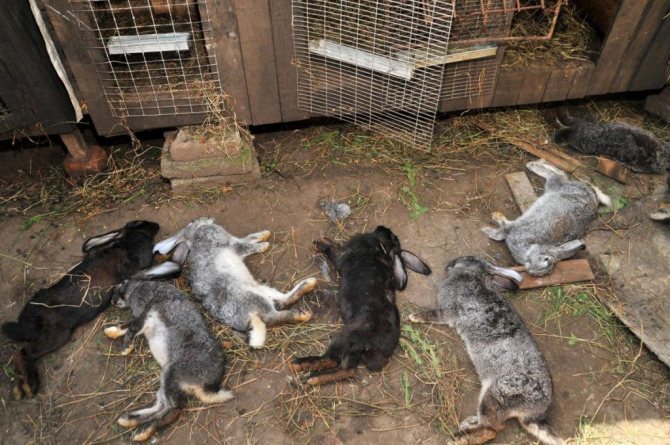

One fell ill - the family, consider it, perished!
If you yourself plan to vaccinate the livestock, then do not forget about the conditions, temperature and storage times of vaccines. A spoiled vaccine will not be beneficial and can be fatal to the vaccinated individual.
Rabbit meat breeds
Feeding rabbits for meat will only be profitable if the breed is chosen correctly.
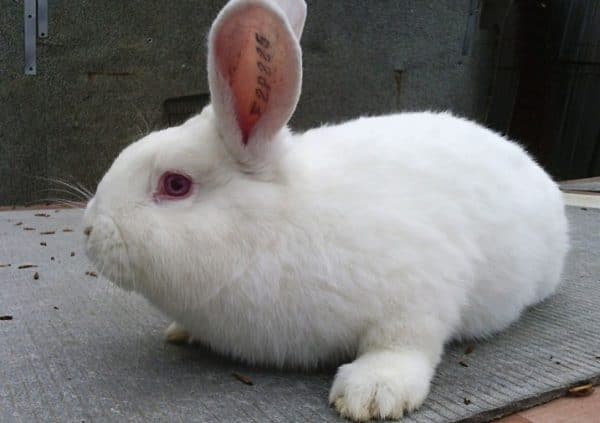

New Zealand White Rabbit
The meat type is characterized by the following features:
- fast growth and stable weight gain;
- high rate of pure product;
- excellent taste of meat.
Not all types of young rabbits are used for breeding and subsequent slaughter.
Suitable meat breeds for fattening include:
- New Zealand white. By 5-6 months, the weight of the animal is 5 kg. During okrol, 9-11 cubs appear. Bunnies can be kept in boxes with mesh flooring.
- New Zealand red. The female is larger than the male. Rabbits gain weight well. At the output, the indicator of pure meat reaches almost 60%.
- Gray giant. The maximum weight is up to 6 kg. The rabbit is able to bring up to 8 cubs. The breed is characterized by early maturity. The quality of the meat is good.
- California breed. Differs in early maturity. During the year, one female brings more than 30 cubs. Taste characteristics of meat and indicators of density and density of wool are appreciated by consumers.
- Poltava silver. The breed is prized for its fluffy fur. Animal meat is pleasant and soft in taste.
- Sheep (or lop-eared rabbit). Weight at the time of slaughter is about 8 kg. For one okrol, the female brings 7-9 pieces. Rabbit meat tastes soft and light.
- Flandre. Animals reach 70 cm in length. Body weight - up to 10 kg. The meat is juicy and tasty. The breed belongs to the late maturing, for breeding requires a wide cage and constant care.
Rabbit breeders prefer the New Zealand white, gray giant and the Californian breed.
Benefits of breeding broiler rabbits
Growing broilers, or, as they are also called, meat rabbits, has a number of such advantages:
- good fertility - the female usually brings from 7 to 9 rabbits;
- rapid maturation of offspring, reaching optimal height and weight by 4 months;
- rabbits have a well-developed maternal instinct, thanks to which the young are raised without much difficulty;
- the ability to use sexually mature rabbits for mating regardless of the season;
- uncomplicated content - they can be grown in mesh cells;
- small feed consumption, because using only 2.5 kilograms of feed, you can get 1 kilogram of rabbit live weight.
Did you know? In Europe, rabbits are in third place in the ranking of popular pets, second only to cats and dogs.
Feeding rabbits for weight gain
Vegetable and forage impurities are introduced into the food of rabbits from 2-3 months. The composition of feed at each age stage is different.
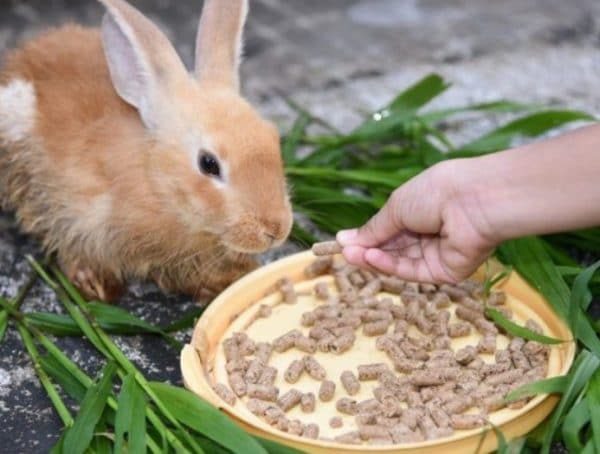

Without special fattening, the farm will not only be left without profit, but will not even recoup the cost of keeping the eared
The process of feeding rabbits involves three stages:
- preliminary (selection of a suitable diet);
- the main (weight gain of pets);
- the final (weight and body fat adjustment).
The first period is characterized by increased feeding of young animals.
In summer and winter, it is based on combined mixtures:


The preparation stage is 5 days.
The main stage is aimed at the formation of the fat layer.
Animal nutrition includes products with fat content:
Porridge with milk is added to the daily diet of rabbits. The feeding period lasts 7-10 days.
How long to feed rabbits
The technology of breeding rabbits for meat provides for three types of fattening from the moment of birth to slaughter:
- long-term feeding (120 days);
- optimal feeding (90 days);
- early fattening (less than 70 days).
The first option is used for raising rabbits at home. The short-term approach is bad for the quality of the product. Animals should be fed for 3 months.
From birth to 4 weeks old, intensive growth of rabbits occurs. The body weight increases from 40-80 g to 500-700 g. Starting from the 5th week and within 1.5-2 months, rabbits gain weight.
After 50 days, a gradual slowdown in the growth of animals occurs. The acceptable age of the animal for slaughter is 84-90 days.
Riesen
This breed was bred in Germany and is still actively used both to improve the qualities of existing breeds and to create new ones.An important feature is its adaptability to the harsh winters of the middle zone.
The body of Risen rabbits is stocky and large. The head is quite large and the limbs are very powerful. The coat is long - up to 4 centimeters. Sand, blue or dark gray color. The weight of an adult male can reach 10-11 kilograms, which is an excellent indicator.
Sexual maturity occurs quite late - rabbits should be allowed to mate no earlier than eight months. Rabbits are quite fertile - they bring up to nine cubs at a time.
Usually, rabbits are sent to slaughter at the age of 4 months. After that, the growth rate is reduced, and the taste of meat in males deteriorates. The meat yield is not too high - rarely higher than 55%. However, the considerable size fully compensates for this disadvantage.
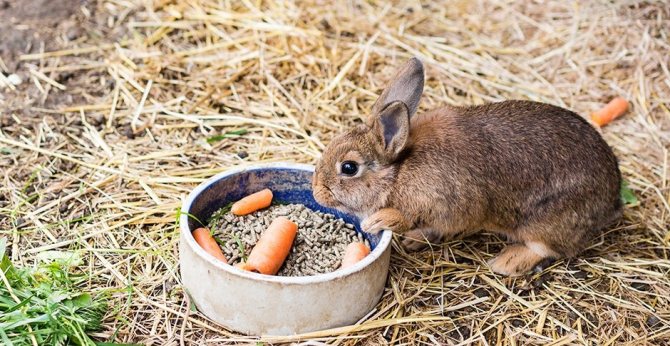

Methods for breeding rabbits for meat
Animal nutrition is the backbone of rabbit farming.
There are two ways to feed rabbits:
In large and medium-sized farms with 200 heads and more, both technologies are being introduced simultaneously. In households, the usual method of feeding is used.
Broiler method of breeding rabbits
The peculiarity of the method lies in the short feeding times of young animals and saving on cages. One feeding cycle takes 90 days.
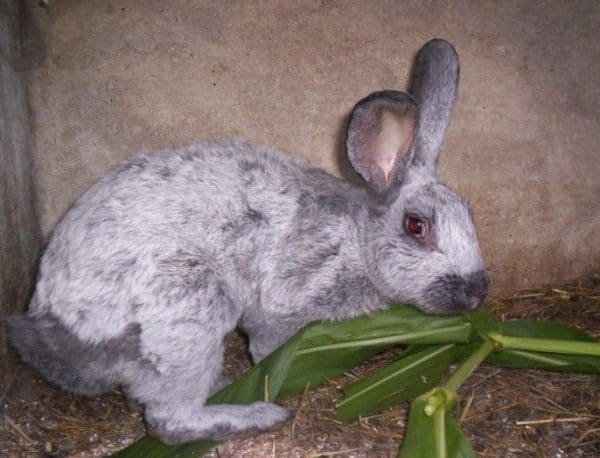

Feeding rabbits at home is not complete without hay and branches of various trees.
During feeding, the rabbits remain with their mother. After finishing feeding, the female is transferred to the male for mating. The rabbit brings up to 24 cubs per year.
It is interesting! Broiler rabbit skins are inexpensively valued, but meat is in great demand due to its nutritional value and taste.
Advantages of the broiler method:
- no need to equip group cages;
- concentration of livestock in one place allows for quick care of rodents;
- with constant feeding on mother's milk, the rabbits reach a weight of 3-4 kg by the third month;
- raising two hundred females at the same time gives about 8 centners of pure meat per year.
The intensive breeding method depletes the immunity of females, reduces milk production. The lack of sanitary norms during feeding leads to a disease of the mammary glands in the rabbit.
The percentage of concentrated impurities for a lactating female is 45-50% in summer and 65% in winter. For the growth of the young, 155 g of protein is added with each feeding. Water is included in the diet in unlimited quantities.
Common method for feeding young rabbits
The use of conventional fattening involves the deposition of young stock from the mother in two months. While the cubs are on suction feeding, the rabbit is provided with an intensive 5 meals a day.
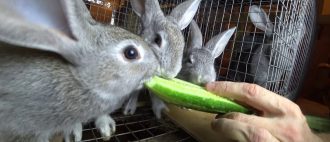

Concentrates form the basis of the diet of rabbits. In the first week, at least 500 g of feed is consumed per pet, of which 450 g is a legume-cereal mixture, 50 g is grain.
By the third and fourth months, feed volumes increase by one and a half, two times. By slaughter, the rate per day (800-950 g) remains.
It is interesting! Regularly fed rabbit meat does not have a high nutritional value. A big profit for breeders is the sale of furry animal skins.
At the age of five months or six months, the animal is slaughtered. By this time, the body weight reaches 4-5 kg.
Red rabbit from New Zealand
Slightly less popular are New Zealand red rabbits.
Like the previous breed, it was bred in the United States back in 1910. The ancestors are wild rabbits and Belgian hares. The breed turned out to be very successful - the rabbits grew quickly and had a fleshy physique. It should be noted that adverse weather conditions did not cause unnecessary problems for the animals, which is very important when breeding on an industrial scale.
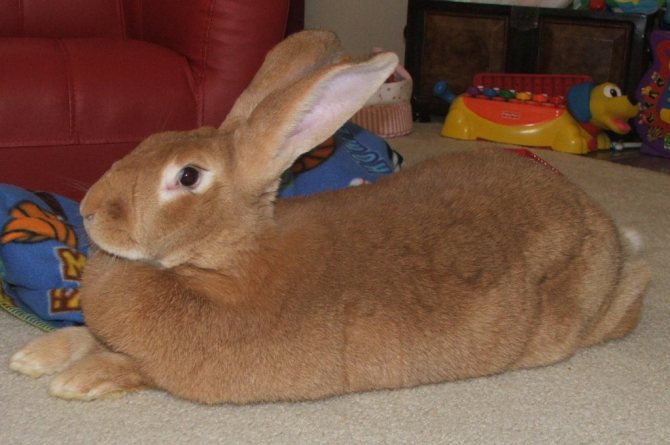

Unlike other broiler rabbits, the breed made it possible to obtain not only high-quality meat in large quantities, but also an excellent skin. The coat is short but soft and very dense.And the color scheme will pleasantly surprise the most picky designer - there are bright red, reddish-yellow and even fiery rabbits. It is quite understandable why the breed took root and began to be bred everywhere.
An adult male weighs about 4 kilograms, and females are even larger - up to 5 kilograms.
Increasing the mass of rabbits in additional ways
Rabbit breeders with extensive experience use auxiliary methods to activate pet weight gain.


The basis of the winter diet of rabbits is roughage and concentrated feed.
Additional productive methods that provide weight gain in animals include:
- Rational seating of rabbits. In a herd, animals are divided into stronger and weaker ones. All pets are required to receive food in equal portions. To do this, you need to group rabbits according to their temperament.
- Limited space. The mobility of the rabbits is limited by the small area. With minimal movement, rabbits can gain weight quickly.
- Control over the filling of the feeder. After each feeding (4-5 times a day), the food container is cleaned out. Empty food boxes are refilled.
Breeders successfully use another feature of rodents - activity at night. Shielding the cage from daylight increases the rabbits' need for food. But regular overexposure of animals in semi-darkness is contraindicated.
Advice to those wishing to build a business on rabbits
In conclusion, I can once again wish you success, as well as stable profits and a rich offspring. Don't rely on luck, farming is 99% labor and only 1% luck. Try to master the niche of marketing, purchasing feed and selling by-products as widely as possible within your region.
Do not give up and do not step back, because I was able to do this, having lived all my life in a city where all my experience in animal husbandry was two hamsters and a cat. As the ancient philosophers said, “Experience is a reward for our mistakes,” so try, believe in yourself and you will definitely succeed!
I wish you success!
Food supplements for artificial mass gain
Breeders add vitamins to pet food to improve appetite. Useful substances of groups A and E are used together with fats, vitamin D is added to thick and mushy feed. The drink is diluted with vitamin C.
After consulting a veterinarian, the animals are prescribed vitamin-mineral supplements, as well as protein-vitamin-mineral supplements (BVMD).
They strengthen the body of animals with useful microelements: manganese, calcium, phosphorus. Protein-rich options provide animal muscle with protein.
Vitamin and protein supplements have no contraindications. The correct dosage is calculated taking into account the body weight and age of the pet. The use of additives above the norm impairs the taste characteristics of rabbit meat.

